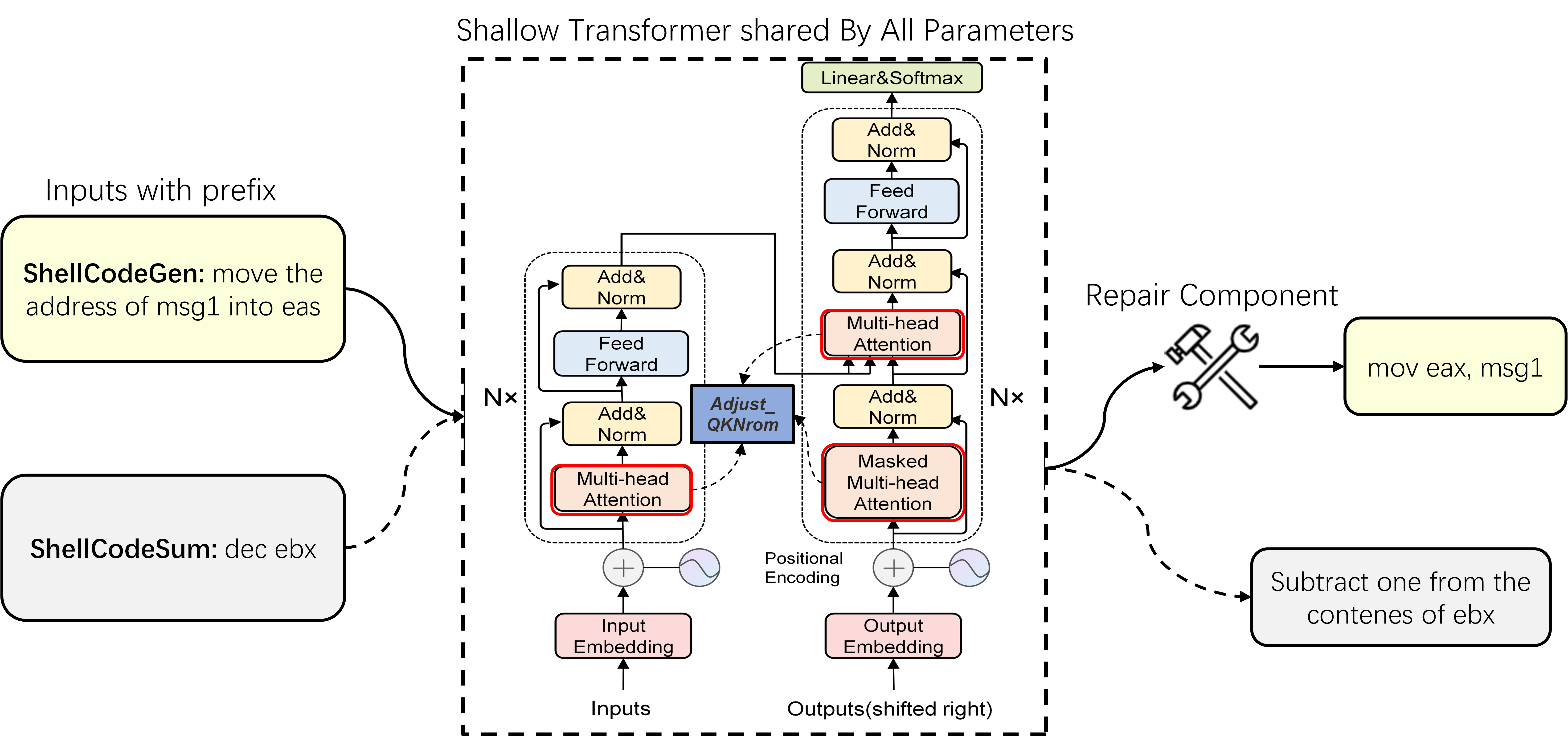The source code and dataset for "DualSC: Automatic Generation and Summarization of Shellcode via Transformer and Dual Learning"
What's New?
We add BPE tokenization + repair component to the first version and are surprised to find a considerable performance improvement, so we update out the latest model code as well as the generated result files.
First Version:
Summarization: BLEU-4: 57.477; ROUGE-L: 66.763; METEOR: 38.706
Generation: BLEU-4: 77.614; ROUGE-L: 79.576; METEOR: 63.438
New Version:
Summarization: BLEU-4: 60.059; ROUGE-L: 69.969; METEOR: 41.711
Generation: BLEU-4: 77.502; ROUGE-L: 84.213; METEOR: 70.938
How to run?
1.Make sure the data you used need add the prefix to distinction the two dual task.
2.First run "train_tokenizer.py".
3.Modify the "vocab_size" in Config/config.json according to the vocab.josn's length.
4.Modify the other Hyper-parameter in Config/config.json, if you need.
5.Just run "run.py" and the result files can be generated in "test_output".
Code Implementation Details
1、compute init g0
threshold_wordcount = np.percentile([len(i) for i in train_data.src] + [len(i) for i in valid_data.src] + [len(i) for i in test_data.src], 97.5)
def scaling_factor(sequence_threshold):
return np.log2((sequence_threshold ** 2) - sequence_threshold)
class ScaleUp(nn.Module):
"""ScaleUp"""
def __init__(self, scale):
super(ScaleUp, self).__init__()
self.scale = nn.Parameter(torch.tensor(scale))
def forward(self, x):
return x * self.scale
#scaleup is the learnable parameter g for training.
scaleup = ScaleUp(scaling_factor(sequence_threshold)) 2、modify the self-attention
class MultiHeadAttentionLayer(nn.Module):
def __init__(self, d_model, n_heads, sequence_threshold=threshold_wordcount):
super(MultiHeadAttentionLayer, self).__init__()
assert d_model % n_heads == 0
self.d_model = d_model
self.scaleup = ScaleUp(scaling_factor(sequence_threshold))
self.n_heads = n_heads
self.head_size = d_model // n_heads
self.fc_q = nn.Linear(d_model, d_model)
self.fc_k = nn.Linear(d_model, d_model)
self.fc_v = nn.Linear(d_model, d_model)
self.fc_o = nn.Linear(d_model, d_model)
def forward(self, query, key, value, mask):
"""
:param Tensor[batch_size, q_len, d_model] query
:param Tensor[batch_size, k_len, d_model] key
:param Tensor[batch_size, v_len, d_model] value
:param Tensor[batch_size, ..., k_len] mask
:return Tensor[batch_size, q_len, d_model] context
:return Tensor[batch_size, n_heads, q_len, k_len] attention_weights
"""
Q = self.fc_q(query) # [batch_size, q_len, d_model]
K = self.fc_k(key) # [batch_size, k_len, d_model]
V = self.fc_v(value) # [batch_size, v_len, d_model]
Q = Q.view(Q.size(0), -1, self.n_heads, self.head_size).permute(0, 2, 1,
3) # [batch_size, n_heads, q_len, head_size]
K = K.view(K.size(0), -1, self.n_heads, self.head_size).permute(0, 2, 1,
3) # [batch_size, n_heads, k_len, head_size]
V = V.view(V.size(0), -1, self.n_heads, self.head_size).permute(0, 2, 1,
3) # [batch_size, n_heads, v_len, head_size]
# Here is the zero mean adaptation
mean = torch.mean(Q, dim=-1)
mean = mean.unsqueeze(-1)
Q = Q-mean
mean = torch.mean(K, dim=-1)
mean = mean.unsqueeze(-1)
K = K-mean
# Here is the modifications
# scores = torch.matmul(Q, K.transpose(-1, -2)) # [batch_size, n_heads, q_len, k_len]
# scores = scores / torch.sqrt(torch.FloatTensor([self.head_size]).to(Q.device))
Q = F.normalize(Q, p=2, dim=-1)
K = F.normalize(K, p=2, dim=-1)
scaleup = self.scaleup
scores = scaleup(torch.matmul(Q, K.transpose(-2, -1)))
if mask is not None:
scores = scores.masked_fill(mask == 0, -1e18)
attention_weights = F.softmax(scores, dim=-1) # [batch_size, n_heads, q_len, k_len]
context = torch.matmul(attention_weights, V) # [batch_size, n_heads, q_len, v_len]
context = context.permute(0, 2, 1, 3).contiguous() # [batch_size, q_len, n_heads, v_len]
context = context.view(context.size(0), -1, self.d_model)
context = self.fc_o(context) # [batch_size, q_len, d_model]
return context, attention_weights3、dual learning in DualSC
Let the model learn two dual tasks by adding a prefix, as in T5.
Requirements
pytorch 1.8
tokenizers 0.10.3
numpy 1.19+
nlgeval

